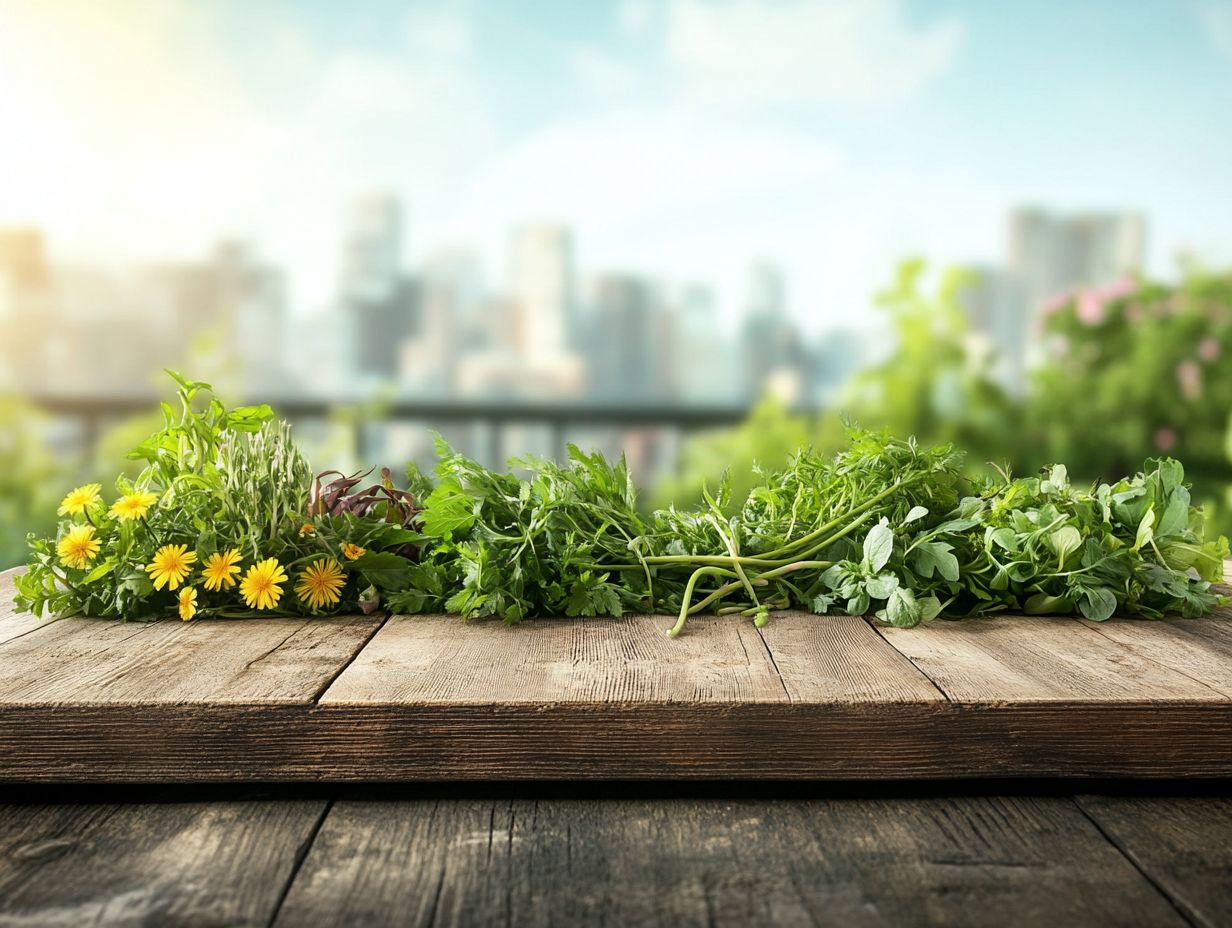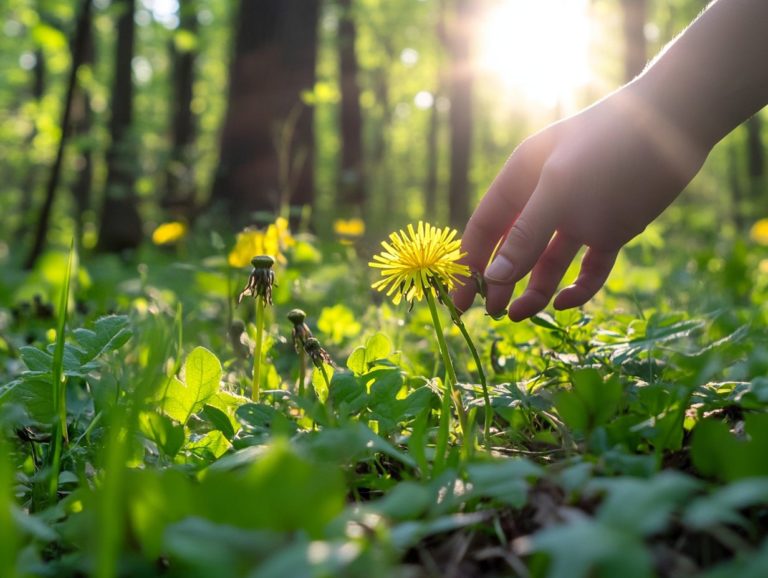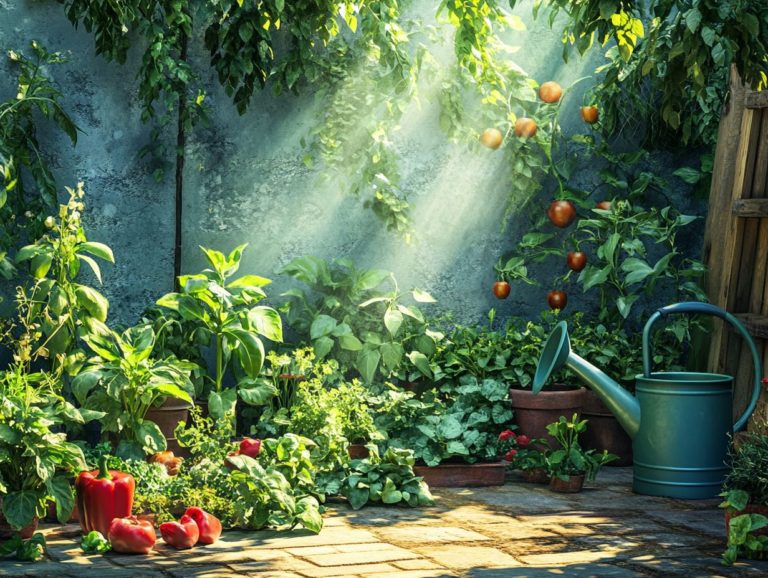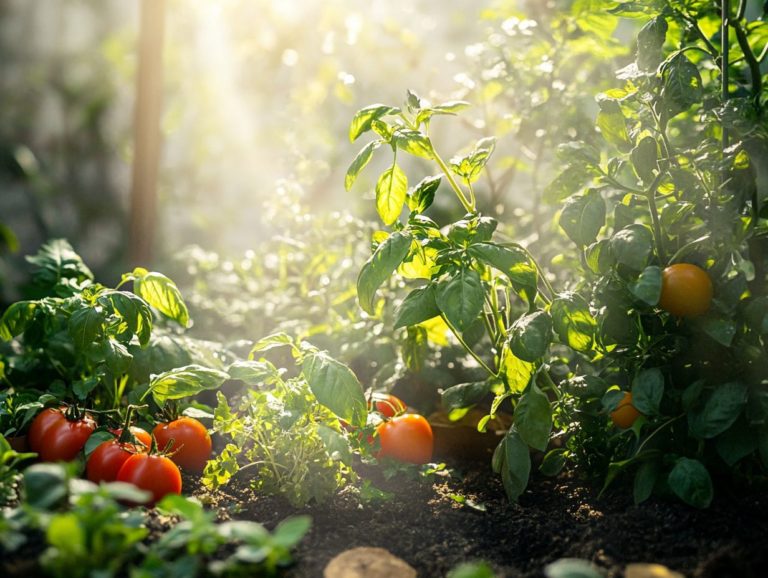10 Edible Plants Found in Urban Areas
Urban landscapes may be dismissed as mere concrete jungles. Yet nestled within the sidewalks and parks lie a wealth of edible plants, eager for your discovery.
Dive into the world of urban foraging today and elevate your meals with these nutrient-packed plants! This article delves into ten common yet frequently overlooked plants, ranging from dandelions to elderberries, that not only enhance your meals but also deliver impressive nutritional benefits.
You ll receive a comprehensive guide on how to identify these plants, safely harvest and prepare them, and seamlessly incorporate them into your diet while also addressing any potential risks.
Embark on this green adventure right in your own urban backyard and discover wild berries, wild garlic, and other hidden treasures!
Contents
- Key Takeaways:
- 1. Dandelions
- 2. Chickweed
- 3. Purslane
- 4. Clover
- 5. Wild Garlic
- 6. Wild Strawberries
- 7. Nettles
- 8. Mulberries
- 9. Elderberries
- 10. Rose Hips
- What Are Edible Plants?
- Frequently Asked Questions
- What are the benefits of finding and consuming ten edible plants in urban areas?
- How can I identify ten edible plants in urban areas?
- Are all ten edible plants found in urban areas safe to eat?
- Curious about common edible plants in urban areas? Check out these tasty finds!
- Can I find ten edible plants in any urban area?
- What are some ways to use ten edible plants found in urban areas?
Key Takeaways:

- Look out for dandelions, chickweed, purslane, and clover in urban areas for a quick and easy snack.
- Boost your immune system with the nutritional benefits of wild garlic, wild strawberries, nettles, mulberries, elderberries, and rose hips found in urban areas.
- Always properly identify and harvest edible plants in urban areas to avoid potential risks. Explore creative ways to incorporate them into your diet for a healthier lifestyle.
1. Dandelions
Dandelions are often seen as both delightful edible plants and pesky weeds, offering a treasure trove of benefits for urban foragers and health enthusiasts alike. They provide a rich source of vitamins and minerals.
These plants serve as a versatile ingredient in salads, teas, and even dandelion coffee, making them a staple in the wild food community. Packed with antioxidants, dandelions enhance your overall wellness.
Their impressive calcium and iron content supports strong bones and healthy blood. Their culinary options go beyond just the leaves; both the flowers and roots boast unique flavors and uses that can elevate your dishes.
In traditional medicine, dandelions have long been valued for their diuretic properties and potential liver benefits, acting as a natural detox aid. If you re keen on foraging, remember to gather them from chemical-free areas, especially given their abundance in urban landscapes.
A little caution goes a long way always ensure you can safely identify them and avoid picking from treated lawns to fully enjoy the remarkable bounty this plant has to offer.
2. Chickweed
Chickweed is an often-overlooked edible plant that flourishes in urban gardens and wild spaces. Its nutritious leaves and delicate flavor make it a favorite among foragers seeking out options for salads and garnishes.
With its charming small white flowers and sprawling green growth, this versatile herb brings a fresh burst of taste to your dishes. It packs a punch of vitamins and minerals, including Vitamin C, potassium, and iron.
Adding chickweed not only elevates the flavor profile of your meals but also boosts their nutritional value. You can blend it into smoothies or sprinkle it atop sandwiches. You may also find it alongside garlic mustard and dandelion greens.
Chickweed is also celebrated for its ecological significance, signaling healthy soil and biodiversity. By incorporating this green gem into your daily meals, you embrace a healthier lifestyle and highlight its ability to enhance both your dishes and your overall well-being.
3. Purslane
Purslane, a succulent with a distinctive tangy flavor, is a superb addition to your urban foraging adventures. This resilient plant thrives in gardens and sidewalks, celebrated for its impressive omega-3 fatty acid content and antioxidant properties.
Identifying this versatile gem is effortless; its fleshy, red-tinged stems and thick, oval leaves set it apart from other greens. As a culinary enthusiast, you ll appreciate its crisp texture and knack for elevating salads, soups, and stir-fries, making it a go-to ingredient during the summer months.
Beyond its culinary allure, this vibrant green not only tastes great but also helps keep you healthy! It boasts various medicinal benefits, including anti-inflammatory properties and support for heart health.
As a sustainable option, purslane flourishes abundantly in urban environments, enabling you to gather it easily without disrupting local ecosystems. By weaving this remarkable plant into your everyday meals, you amplify flavor and embrace a healthier lifestyle.
4. Clover
Clover, often brushed off as a mere lawn weed, is actually a treasure trove of edible plants that offers a remarkable array of nutritional benefits and distinctive flavors. Don’t miss out! It s time to welcome it into your salads, stir-fries, and herbal teas, especially if you’re part of the foraging community.
This diverse genus encompasses species like white clover, red clover, and yellow clover, each boasting its own unique edible parts. The leaves and flowers are not just palatable; they re also brimming with vitamins and minerals that enhance your diet. For instance, young leaves can add a mild, sweet flavor to your salads, while the flowers are perfect for infusing teas or serving as elegant garnishes.
Practicing sustainable foraging is key. Only harvest what you can truly use to ensure that plenty of clover remains to flourish and support local ecosystems. By embracing clover, you elevate your meals and adopt a responsible approach to enjoying nature’s bounty.
5. Wild Garlic
Wild garlic is a fragrant herb that thrives in damp, wooded areas, delivering a strong taste that elevates various dishes. It serves as a delightful substitute for cultivated garlic, particularly favored by urban foragers who love foraging.
Typically available from early spring to late summer, wild garlic can be easily identified by its broad, green leaves and the charming white star-shaped flowers that blanket the forest floor. This versatile herb can be utilized in a wide array of dishes from soups and pestos to salads and toppings transforming your ordinary meals into gourmet experiences.
Wild garlic also offers health benefits, including may help fight germs and support heart health. When harvesting it, be sure to differentiate it from poisonous plants like lily of the valley by noting its distinct aroma.
Incorporating this herb into your recipes not only enhances flavors but also introduces a range of nutrients, including wild chives, making it a delightful addition to any kitchen.
6. Wild Strawberries

Wild strawberries are a sweet treat just waiting to be picked in many urban areas, offering a sweet flavor along with a plethora of nutritional benefits. They re a true gem for anyone diving into the world of urban foraging.
Spotting these small, red treasures can be a rewarding endeavor; they tend to grow close to the ground and showcase bright green, heart-shaped leaves that distinguish them from other berries. Both gardeners and culinary enthusiasts treasure their unique flavor profile, which perfectly balances sweetness with a subtle tartness, making them ideal for enhancing desserts or crafting homemade jams.
But it s not just about taste these berries are packed with vitamins C and A, fiber, and antioxidants, solidifying their role in a nutritious diet. Foraging for wild strawberries in city parks and gardens is a great chance to reconnect with nature today while providing a refreshing escape from the urban hustle.
7. Nettles
Nettles, often regarded with trepidation for their stinging qualities, are actually a treasure trove of nutrition. When cooked or dried, they lose their sting and transform into a delightful addition to soups, teas, and more, celebrated for their impressive health benefits in the foraging community.
These hardy green plants typically thrive in damp woodlands, along riverbanks, and in disturbed urban areas, making them relatively easy for you to identify and harvest. The tender young leaves, best collected in spring, are packed with vitamins A, C, K, and iron, offering a wealth of nutritional advantages.
You can remove their sting by simply blanching the leaves in hot water or saut ing them; this will enhance their texture and flavor beautifully. Traditionally, nettles have played a significant role in herbal medicine, addressing a variety of ailments from respiratory issues to arthritis pain, thereby solidifying their place in the rich tapestry of local wild food culture.
8. Mulberries
Mulberries are sweet, juicy fruits that you can find in urban areas. They make for a delightful snack and can be used in various recipes.
Identifying mulberry trees is easy. They have beautiful leaves that lose their foliage in winter and fruits that range in color from white to black.
Timing is crucial for harvesting. Pluck these fruits from late spring to early summer when they reach peak ripeness.
Mulberries are also packed with nutrients. They’re rich in vitamins C and K and fiber, which helps with digestion, making them a valuable addition to your balanced diet.
Incorporate these berries into your meals to elevate your overall health. They enhance digestion and provide antioxidant support while offering a tempting choice for cooking or snacking.
9. Elderberries
Elderberries are tiny treasures bursting with flavor! These dark berries cluster on elder trees and offer numerous health benefits.
For foragers, they are a prized find used in syrups and jams. Look for elderberry plants near rivers and wetlands.
However, be careful; raw elderberries can be toxic. They must be cooked or processed properly to become delicious additions to your pantry.
People cherish elderberries not just for their culinary versatility but also for their role in traditional medicine. Many turn to these berries for remedies against colds and flu, solidifying their esteemed status in the natural bounty around us.
10. Rose Hips
Rose hips, the often-overlooked gems of wild roses, are a treasure trove of vitamin C and antioxidants. If you’re interested in urban foraging or natural health, these vibrant berries are essential additions to your diet.
Identifying these striking reddish-orange fruits is straightforward. They typically appear after the flowers have wilted, making their entrance from late summer to early fall.
While foraging, keep an eye out for rose hips on wild rose bushes, often found in hedgerows, along woodland edges, and even in urban landscapes.
Harvest rose hips from late September to November for the best flavor.
In the kitchen, the culinary possibilities are endless. You can brew rose hips into soothing teas, create delicious jams, or use them as a natural sweetener in syrups. Packed with vitamins A and E and essential fatty acids, these remarkable fruits not only elevate your dishes but also help bolster immune function and enhance your overall well-being.
What Are Edible Plants?
Edible plants encompass a remarkable array of flora that you can safely enjoy, from garden vegetables to wild food sources, including the top 10 common edible weeds that urban foragers delight in.
These plants provide nourishment and foster a profound connection to nature and sustainable practices. Consider common varieties like leafy greens, herbs, fruits, and legumes. Each contributes essential vitamins, minerals, and antioxidants vital for your health.
Take kale and spinach, for instance they’re brimming with iron and vitamin K. Berries, too, offer delightful sweetness and a wealth of antioxidants.
By incorporating these diverse species into your daily meals, you can enrich your diet and promote overall well-being. Understanding the nutritional benefits of local flora allows you to appreciate your surroundings more deeply while encouraging eco-friendly habits.
How Can One Identify Edible Plants in Urban Areas?

Imagine the thrill of discovering delicious plants right in your neighborhood! Identifying edible plants in urban areas gives you the power to distinguish between common edible species and potentially harmful plants. For those looking to expand their culinary horizons, exploring these 10 must-try edible plants for adventurous eaters ensures your foraging adventures are both safe and rewarding.
To embark on this enriching journey, you should start by familiarizing yourself with key characteristics such as leaf shape, flower color, and growth patterns. These elements are crucial for making accurate identifications.
Utilizing resources like field guides and mobile apps will become invaluable in your quest. They provide images and detailed descriptions that enhance your learning experience.
Tapping into local knowledge through community workshops or foraging classes can significantly sharpen your skills. Experienced foragers can impart invaluable tips and personal insights that elevate your understanding.
Engaging in local foraging groups or online forums can also offer tremendous support. This allows you to connect with others and exchange information about safe yet delicious finds in your urban landscape.
What Are the Nutritional Benefits of Edible Plants?
Edible plants are brimming with essential nutrients, including vitamins, minerals, and antioxidants. They offer significant health benefits that can elevate your overall well-being, especially when you incorporate them into your meals regularly.
These green gems, often found in the wild, are not just delicious; they play a crucial role in addressing common nutritional deficiencies. For example, dandelion greens serve as a rich source of vitamins A and C, while nettles are packed with iron and calcium, perfect for boosting your iron levels and supporting bone health.
Adding foods like purslane, which is loaded with omega-3 fatty acids and antioxidants, can significantly improve your cardiovascular health. Exploring these wild edibles allows you to enrich your diet with diverse flavors and robust nutrition, ultimately steering you toward better health outcomes.
How Can One Safely Harvest and Prepare Edible Plants?
Successfully harvesting and preparing edible plants requires a deep understanding of safe foraging practices. It also involves the right techniques to clean and cook these wild foods. This knowledge boosts health benefits and elevates your cooking experience.
Equipping yourself with the right tools think sharp knives, sturdy baskets, and protective gloves is essential for a seamless foraging adventure. Familiarizing yourself with local flora can significantly enhance your chances of discovering safe and delicious options.
You can t underestimate the importance of proper identification. Mistaking plants can lead to serious health risks, particularly with toxic varieties like poison hemlock potentially lurking in the underbrush.
By embracing best practices for washing and preparing your gathered edibles, you can relish a nutritious addition to your meals while savoring the rich flavors of nature s bounty.
What Are the Potential Risks of Eating Edible Plants?
While many edible plants offer a wealth of nutritious benefits, it s essential to recognize the potential risks that come with foraging for wild foods. Misidentifying poisonous plants, like poison hemlock, poses significant dangers, and proper preparation is crucial to avoid adverse effects.
Even experienced foragers can find themselves enchanted by a seemingly harmless leaf that turns out to be quite the opposite. For example, one seasoned forager recounted a chilling experience of mistaking wild carrot for its toxic counterpart, hemlock, which nearly led to a life-threatening situation.
Different species often demand specific cooking methods to neutralize harmful compounds. Consider the infamous golden chanterelle; if not cooked properly, it can result in uncomfortable digestive issues. This highlights the vital importance of thorough research and education in the art of foraging, ensuring that the joy of gathering wild foods doesn t come with serious risks.
How Can One Incorporate Edible Plants into Their Diet?
Incorporating edible plants into your diet can be a truly rewarding experience, enhancing your meals with unique flavors. This approach also offers impressive nutritional benefits while promoting an eco-friendly way to source food within urban environments.
By exploring local parks, backyards, and even city streets, you can uncover a treasure trove of wild edibles just waiting to be harvested. Simple recipes, like tossing dandelion greens into your salads or saut ing foraged mushrooms for a delightful pasta dish, make it easy to weave these vibrant plants into your everyday cooking.
Techniques such as drying and pickling not only extend the shelf life of your foraged finds but also open the door to creative cooking. Engaging in this pursuit allows you to foster a sense of community as you share experiences and favorite discoveries with others, bonding over the joy of seasonal bounty and the thrilling journey of uncovering nature’s hidden gems.
Frequently Asked Questions
What are the benefits of finding and consuming ten edible plants in urban areas?

There are several benefits to finding and consuming ten edible plants to try in your next meal in urban areas. These plants are often more nutrient-dense than store-bought produce, they are free, and they can help you connect with your local environment. Consuming wild plants is fun and rewarding.
How can I identify ten edible plants in urban areas?
To identify ten edible plants you can find in your garden in urban areas, look for key characteristics such as the plant’s growing season, colors, and textures of different plant parts. Having a guidebook or an experienced forager can also be extremely helpful.
Are all ten edible plants found in urban areas safe to eat?
While most edible plants found in urban areas are safe to eat, it is important to properly identify them before consuming. Some plants may have poisonous look-alikes, so it is crucial to be cautious and certain before consuming any wild plants.
Curious about common edible plants in urban areas? Check out these tasty finds!
Common ten edible plants found in urban areas include dandelion, purslane, chickweed, clover, and wild garlic. These plants are often considered weeds, but they are actually packed with nutrients and can be used in a variety of dishes, including those listed in the 5 best edible plants for urban foraging.
Can I find ten edible plants in any urban area?
Yes, it is possible to find ten edible plants in most urban areas. However, be mindful of where the plants are growing and avoid areas that may have been treated with pesticides or other chemicals. For those interested in growing their own, check out this list of edible plants to cultivate at home. Be sure to follow local laws to enjoy your foraging adventure safely!
What are some ways to use ten edible plants found in urban areas?
There are countless ways to use top 10 edible plants to harvest sustainably found in urban areas. Some ideas include making salads, soups, or smoothies with wild greens, using flowers to garnish dishes, or even making teas or infusions with medicinal plants. The possibilities are endless!
Ready to explore your urban jungle? Start your foraging adventure today!






